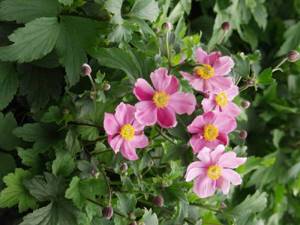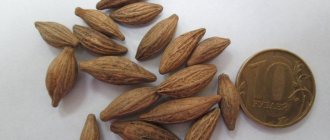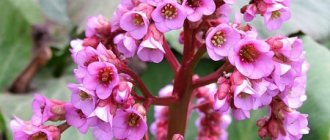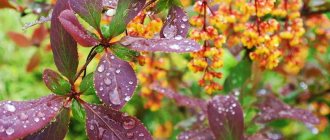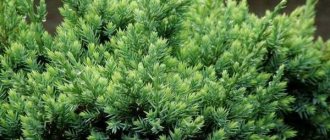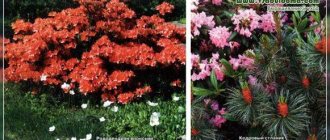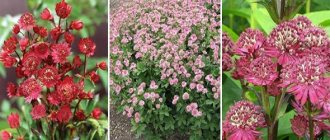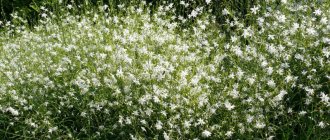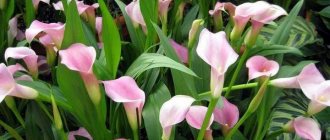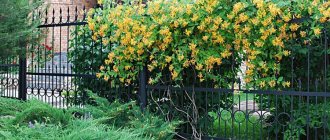Loading…
Loading…
Anemones, photos of which show the beauty of these plants, are represented by 172 species. But the variety of these garden flowers is not limited to this figure: many varieties have been bred that have an original appearance. They will decorate any flowerbed and area.
The second name of anemone is anemone, or “Daughter of the Winds”: this is how the name of the plants is translated from Greek. Delicate flower petals begin to flutter at the slightest breath, smoothly swaying on their long and thin peduncles.
Hybrid anemone (Anemone ×hybrida)
Hybrid anemones are a species artificially created by flower breeders for use in landscape design. They were obtained by crossing the Japanese variety with Anemone vitifolia.
Examples of varieties:
- 'Queen Charlotte' with semi-double flowers of rich pink color.
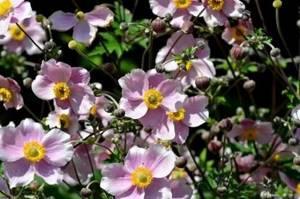
- 'Honorine Jobert' with white petals.

- 'Rosenschale', whose stems reach a height of 60–85 cm. It has large pink flowers.
Flowering of most varieties of the species occurs in September-October, and ends only with the onset of constant cold weather.
Blue anemones "Fokker" and "Sant Brigitte"
In gardening, a very popular varietal group of blue anemones with bright and pale flower colors, these include:
- “Sant Brigitte” is a plant up to 30 cm high, blooming with pale blue buds from late April to early summer;
- "Mr. Fokker" is a miniature perennial that, from April to May, turns into a profusely flowering bush-bouquet with numerous buds of blue and blue colors.
Dubravnaya (Anemone nemorosa)
This variety is also called "white" due to the natural color of the petals. Based on the plant, varieties with other colors have been bred: pink, lilac, bluish. The structure of the flower can be either simple or semi-double. The height of the stems is small - only 20–30 cm, and the diameter of the flowers does not exceed 3.5 cm.
Oak anemone blooms in the spring - almost immediately after the snow melts. The flowering period lasts almost a whole month. Already in June, the leaves begin to acquire a yellow tint, and by the height of summer they dry out completely. The variety is propagated by seeds, but due to their poor preservation, dividing the bush is more often used. You can appreciate the modest beauty and features of this anemone from the photo.
Oak anemone has an important advantage - unpretentiousness in the middle climate. The “historical” homeland of the plant is the forests of central Russia, where it can be seen in the spring forest. Therefore, white anemone grows in the garden without difficulty: it is enough to plant it in a shaded corner, because in nature it is located under the canopy of trees. She also loves moisture.
Another feature of the variety is the strong branching of the rhizome. If the growth process is not controlled, then soon the oak grove anemone will fill a vast area in the garden. It is also recommended to pick off old flowers so as not to aggravate the situation by self-sowing.
There are artificially bred varieties:
- 'Alba Plena' - double white flower;
- 'Allenii' is a rare variety with bluish petals tinged with pink;
- 'Robinsoniana' with lilac color.
Anemone planting methods
Many types of anemones are listed in the Red Book. This is due to the fact that most of these plants are very capricious in reproduction. Moreover, gardeners complain that even cultivated plant varieties are not always easy to propagate.
Some types of this plant can be grown at home. At home, such a flower is grown in a pot.
Such plants are not easy to grow due to the difficulty of planting them. There are two methods that are associated with certain difficulties.
How to plant anemones:
- Planting a plant using seeds is very difficult. The fact is that preparing material for cultivation is very labor-intensive, and even if all the rules are followed and the seeds are freshly collected, only a quarter of the entire selected mass will be able to sprout. At the same time, the flowering of a perennial anemone grown from seeds begins only three years after planting.
- The vegetative method of propagation also takes place. However, it is worth noting that it is also associated with many difficulties. The fact is that with the slightest mistake, not only the daughter branch will die, but also the mother plant.
Unfortunately, there are no alternatives to these methods. Therefore, gardeners have to plant anemones with their help, risking losing most of the seedlings.
Crowned (Anemone coronaria)
Crown anemone is perhaps the most popular plant variety used for garden floriculture. The palette of shades and variety of color structures is amazing. Based on this species, varieties with high decorative properties have been bred. True, caring for such a flower requires some knowledge and attention, but following the rules will help make it the highlight of the garden.
The plant prefers soils with added lime.
The diameter of the flowers can reach 8 cm in diameter. The variety prefers warm climates (its homeland is the Mediterranean), where it grows up to 45 cm in height, but in the climate of the middle zone it does not exceed 20 cm. This anemone is grown as an annual or special measures are used (shelter, digging up tubers) to preserve for the next year.
All plant varieties are divided into 2 broad groups:
- crown anemone de caen ('De caen') with a simple flower structure;
- Anemone St. Brigid ('St. Brigid') with semi- and double.
If you do not dig up the tubers for the winter or plant them in the fall, flowering will begin in late May or early summer (depending on weather conditions). When planting in spring, it occurs in mid-summer and is not very expressive, and the reappearance of buds coincides with the arrival of frost.
Popular varieties:
- Anemone "Admiral" with a crimson color with a soft pearlescent tint and emerald leaves. The height of the plant is approximately 20 cm.
- Fokker, with violet-blue petals. The center of the flower is unusually dark, almost black. It has a semi-double structure and looks luxurious in the flowerbed.
- Anemone 'Lord Lieutenant' is a showy plant with double flowers. Their color is blue, more saturated than that of "Mr. Fokker", and the middle is the same dark. The variety goes well with other flowers in the garden and does not interfere with them.
- "Bicolor" - boasts original white petals. There is a bright purple stripe around their center.
- "Holland" has red flowers with a snow-white center.
- Anemone "Governor" is another bright variety, colored scarlet. It is distinguished by its high doubleness and the white color of the petals at their base. The plant has multiple lush, black stamens.
- 'Sylphide' is a raspberry variety.
- Anemone "De Caen" Mix - suitable for those who want to diversify their flowerbed with a scattering of bright flowers. Their color can be variable: from light to darkly saturated.
- Anemone "Mount Everest" is a plant with neat flowers of increased double size. Numerous petals, collected almost in the shape of a ball, have a light golden center. They are painted snow-white.
Caring for sissies
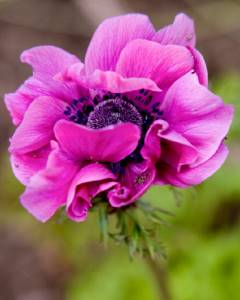
Growing this crop has its own characteristics:
- Planting and choosing a place: before you start planting, you need to choose a place, and then take care of the soil. It should be remembered that anemone roots grow strongly, so it requires a lot of space. Another feature of the plant is that it must be protected from the winds; therefore, it is better to plant it in the center of the garden, where it will be protected from strong gusts. Don't forget about the anemone's love for shade; the best flowering will be in darkened areas.
- Temperature: anemone tolerates weather well from 16°C to 22°C; in winter, during cold periods it needs to be protected from severe frosts.
- Air humidity: before planting, when buds begin to appear, the room temperature needs to be increased to 15°.
- Care: Although anemones do not need careful care after planting, they endure dry times painfully. The soil needs to be drained both before and after planting. Anemone loves sandy soil, so for better growth it is advisable to add ordinary sand. If it turns out that the soil is excessively acidic, which will adversely affect germination, treat it with wood ash or dolomite flour.
- Soil moisture: before flowering, the plant needs abundant watering. You need to keep the soil moist until the very end of flowering.
- Fertilizer: Anemone needs feeding. A weak solution of mineral fertilizers is well suited for this.
Important! Be sure to take into account the fact that the roots of the anemone should not come into contact with the roots of other plants, so before planting, think about how to plant it beautifully and correctly.
Forest (Anemone sylvestris)
This anemone is perennial because it thrives in temperate climates and tolerates winter cold well. She prefers light soils. It grows quickly, forming fluffy cushions of green leaves. The height of the plant varies from 25 to 50 cm. Its slightly drooping flowers are small (from 3 to 5 cm), painted white. They decorate the area at the end of May or at the beginning of June, and the flowering period lasts 2–3 weeks.
Wood anemone blooms longer in the shade than in an open area.
Plant varieties with larger (about 8 cm in diameter) and double flowers have been artificially bred.
Red anemones "Sulfide" and "Bicolor"
Breeders and gardeners pay special attention to red crown anemones, which are often used for forcing and for cutting. These varieties include:
- 'Governor' is a bulbous anemone with spectacular ruby-red flowers. The petals are decorated with a cream-colored ring at the base. Flower diameter up to 10 cm;
- "Don Juan" - the flowers are red, very large, often confused with poppies.
There are also no less original colors of anemone buds, in particular, pay attention to bicolor varieties. Usually these are plants whose petals form a ring contrasting with the main color. These varieties include: crown anemone “Bicolor” (white petals, red ring) and “Holland” (red plates with a white base). Pale white monochromatic petals adorn the varietal group “The Bride”. There are no fewer plants with pink bracts. These include the Anemone Sylphide, the only variety that blooms in the summer, namely from the first days of June to the end of July for 40 days.
Tender (Anemone blanda)
The plants are miniature: they rise above the ground by only 5–10 cm. Flowers, similar to daisies, appear in the spring for 2–3 weeks. Grows in both sunny and semi-shaded areas. The colors of the Blanda anemone are varied.
Popular varieties:
- 'Charmer' with dark pink, almost purple petals.
- "Pink Star", or 'Pink Star', is notable for its soft lavender flowers with a pink tint.
- Anemone “Blue Shades” is colored soft blue, which is reflected in the name of the variety: it translates as “blue shadow”. A popular plant with a modest but charming appearance.
- "Radar" is a garden variety with purple petals.
- “Purple Star” has a two-tone color: the white center effectively harmonizes with the main amethyst tone.
The use of anemone in design
The existence of a huge number of varieties of anemone provides an abundance of techniques for using them in garden design. Low-growing anemones can become border plants or act as the foreground of a flower garden. The higher the plant, the closer to the center of the collective planting they should be located.

If you use several colors or types, you can get a flower garden that will delight you with its tints of shades for the whole season. Flowers can be simple or filled with a core of multiple leaves. Their compilation on the site creates a wave-like effect from simple rural decor to aristocratic luxury.
Anemones are ideal in combination with stones. Therefore, they are used to create rock gardens, rockeries and other structures with natural and artificial stone.
Hubei (Anemone hupehensis)
The height of the Hubei anemone ranges from 50 to 120 cm. The flowers are not large in size - their diameter is approximately 5-7 cm, but they look very neat and elegant. They decorate the bush for 2 months: August and September.
Popular varieties:
- 'Kriemhilde', grows well in semi-shaded areas. Its flowers are semi-double, colored a rich pink-purple.
- 'Splendens' is a red variety.
- 'September Charm' is a tall plant, bred in England and in good conditions reaching 1.2 m. The color is soft pink, with a slight gradient transition from an almost white edge to a more saturated center.
Description of anemone De Caen
De Caen is a variety that is perfect for growing in a greenhouse. Anemone de Caen has beautiful flowers and tuberous rhizomes. This herbaceous crowned plant cannot overwinter in the ground; its tubers need proper storage and care even in winter, while anemone or anemone, in addition to the greenhouse, can be planted in open ground.
De Caen is one of the varieties of anemone that does not grow higher than 25 cm. The plant is decorated with small flowers that resemble poppy buds of a variety of colors. With careful care and suitable climatic conditions, flowers are formed throughout the summer.
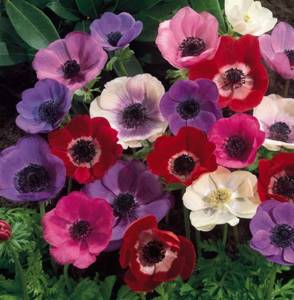
Japanese (Anemone japonica)
Japanese anemone is a small bush, the height of which does not exceed 40 cm, with dark-colored leaves. The colors of the petals are varied. Flowers are grouped into inflorescences. Anemone japonica was renamed Anemone hupehensis during botanical research, and today its name is Anemone scabiosa.
Anemone flowers in their natural habitat are perennial, but in the middle zone they may not withstand winter frosts. But gardeners love them for their beautiful and abundant flowering, albeit short-lived. Growing the plant requires attention, although it is not particularly difficult. The main thing is to choose a suitable place for it, based on the preferences of each variety.
What is the best way to reproduce?
Seeds. This method is not as easy as it seems. Therefore, it is not particularly popular. Having planted the seeds, only 30% will sprout, and flowering will take 2-3 years. You only need to plant the material that was freshly harvested.
With the help of tubers. This method is more popular than the previous one. Anemone tubers, after full flowering, are divided into several pieces (they must have buds).

The next step is to plant the tubers in the ground, but before that, let them soak up some moisture. For better results, add a couple of drops of potassium permanganate or any other substance to the water, which will promote the active growth of anemone.
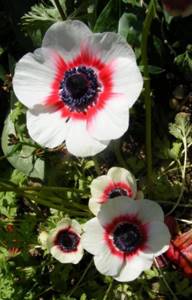
So, your next steps:
- pour peat and sand into a small box;
- place the anemone tubers soaked in water there;
- wrap the top of the box with film;
- place in a cool place;
- After the tubers have sprouted, transplant them into open pots, the depth of which is 2 times greater than they themselves.
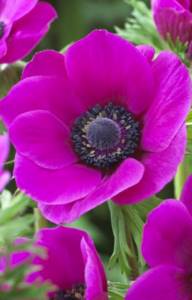
By rhizome - the easiest way of all the others. To give plants a better chance of survival, propagate them either in early spring or late summer. To do this we do this:
- We dig up the anemone and completely clean it;
- if you observe dead roots, remove them;
- then we cut off the young ones and disinfect them with a fungicide;
- After the procedure, leave 2 leaves, cut off all the rest;
- we plant the roots, after germination we water them once every 3 months.

Seed preparation

Caring for and planting anemones (the photo above will allow you to evaluate the decorative qualities of the plant) requires proper preparation of the seed. As soon as all activities for processing the land plot are completed, we proceed directly to the seeds. It is perhaps worth mentioning in advance that anemone has a rather low germination rate. If you plan to use planting material that was harvested last year, be prepared for the fact that at best 25% of seedlings will germinate from it. Although in gardening there are some clever tricks that can increase the percentage of seed germination. To do this, it is necessary to expose the planting material to extreme cold for a couple of months. For experienced gardeners, this event is better known as “stratification”:
- Take anemone seeds and add a small amount of peat or sand to them. You should end up with a mixture consisting of 1 part seeds and 3 parts soil.
- After this, we spray this mixture with water and continue to keep it moist until the seeds swell.
- Select a suitable container and place the seeds in it. You will also need to add a small amount of substrate here, after which the earth will be slightly moistened again.
- After this, the containers must be left in a well-ventilated area where the air temperature does not rise above 5 degrees. Here they will remain until the first shoots appear.
- As soon as the seeds hatch, they must be transferred outside and buried in the ground or snow. To protect from severe frosts, the place where the seeds will lie must be covered with straw or sawdust.
- The plant is transplanted into boxes in the first weeks of spring.
Although there is a faster way to prepare anemone seeds for planting. To do this, you need to take boxes of soil, plant seeds in them, and then bury the containers directly on the site. As a result of the fact that the crops will spend the entire winter outside, a stratification effect will be ensured under natural conditions. With the onset of spring, the boxes are removed from the ground. All that remains is to transplant the seedlings to a new location.
Planting in open ground
The material is planted at a distance of 2 cm from each other. Sprouts and adult flowers will not be crowded. When they bloom, the leaves will fall off.
The perennial tuber looks like a very small beet. At the top there is a compaction left after cutting the stem. This side should face up when landing. The bulb is immersed to a depth of no more than 5 cm. If there are doubts about planting, it is better to place the flower on its side.
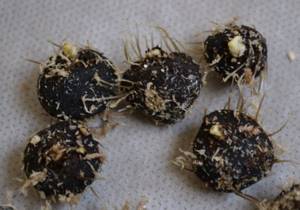
Anemone tubers
How to care for seedlings
Not only the choice of anemone flower seeds is important, but also further planting and caring for it. Flower growers indicate that anemone seedlings should be kept in growth conditions at a temperature not lower than +16 degrees. If this value is increased, the plant will grow poorly and dry out completely.

The duration of daylight hours is at least 12-14 hours. For this reason, if possible, the plant should be provided with artificial light.

The procedure for caring for plants planted in pots consists of systematic watering. The soil should not be dry, it should be moistened if necessary.
